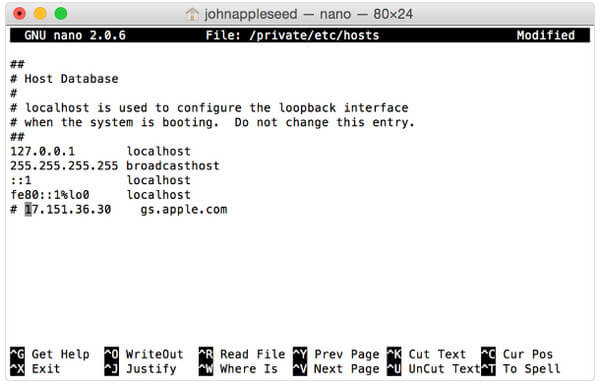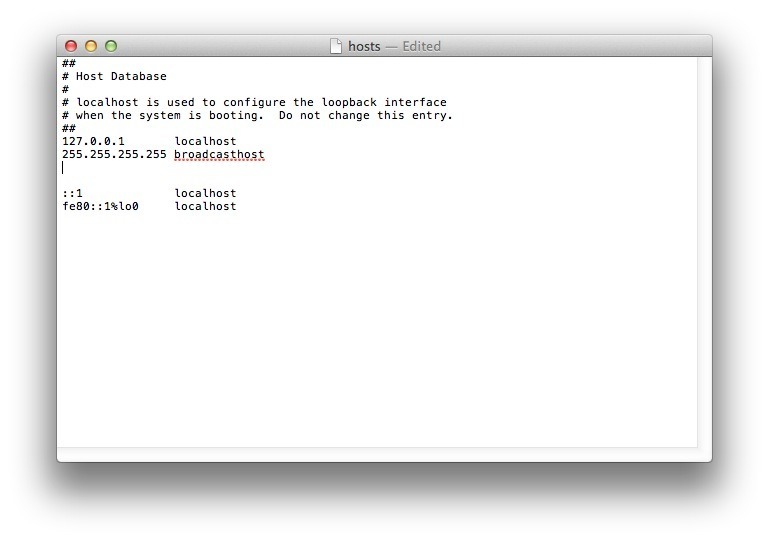

To accomplish this, enter the following command at the Terminal prompt: For the new settings to take effect you will have to flush your DNS cache. You will now return to the main Terminal prompt.Ĩ. Then exit the hosts file in Terminal by pressing Ctrl-x. This will bring up a prompt for the file name to write to:ħ. To save the hosts file after editing the entries, press Ctrl-o. In the following example, I am adding an entry to display a copy of a website residing on my local server, rather than where the DNS is pointing.Ħ. Use your Arrow Keys to move the cursor to a blank space at the bottom of the hosts file, and enter your new mapping here. A couple of default mappings will also appear in the window, such as the entry 127.0.0.1 for localhost.ĥ. The lines starting with the hash (#) symbol are comments and are not to be edited. To move throughout the hosts file, use your arrow keys to move up and down. The hosts file will display in the Terminal window: Terminal will now ask you to enter your Administrator Password:Ĥ. Open Terminal and to open the hosts file, enter the following command:ģ. Cmd+spacebar to open Spotlight and search for TerminalĢ.
HOST FILE FOR MAC HOW TO
The steps below outline how to change your hosts file in order to view a website located on a different server than the live version.īelow is a quick reference on how to go about editing your ETC / Hosts file in Terminal (Mac):ġ. For OS X Lion and OS X Mountain Lion, open Terminal and use the following command.From time to time you may find that you need to view a website that is hosted locally.įor instance, when conducting page load speed tests for a client, we first created a copy of their website on our servers to test the differences in the hosting resources between the two servers to determine if changing hosting providers might positively increase their site’s overall speed.

You can open it with Nano by executing the following command: sudo nano /private/etc/hosts. We will use Nano text editor to open the hosts file.

HOST FILE FOR MAC WINDOWS
The command I'm using is: sudo echo '192.168.99.100 test' > /private/etc/hosts This method does work on windows & linux but on M. Follow these steps to open your hosts file on Mac: Access launcher ( F4 key) and type in terminal in the search field. The the correct changes have not occurred, it may be needed to clear the DNS cache. I'm trying to append a line to the hosts file on a mac.

This will locate the hosts file in the ‘etc’ folder. Then type /private/etc/hosts and press Go. An alternative to the Terminal application is to use TextEdit instead. How to edit the hosts file with TextEdit. Now open a Web browser to test the changes. This clears your Mac’s DNS caches so that the old directory doesn’t conflict with your newly updated hosts file.
HOST FILE FOR MAC PASSWORD
Choose “Replace” and then enter the administrative user password to authenticate the transfer. If the Finder window is closed, use the Finder > Go > Go to Folder command, to reopen it.Īfter the hosts file has been dropped to its original location, OS X will ask you what to do about the unmodified hosts file that’s already there. Then, drag and drop the hosts file from your Desktop back to its original location at /private/etc. Open Terminal and type the following command, replacing “with the website of your choice: ping After the changes have been made to the host files on Mac, save it in its current location on the Desktop. Another method is to type the IP address of a valid site instead of 0.0.0.0. To find a website’s IP address, you can “ping” the site via Terminal.


 0 kommentar(er)
0 kommentar(er)
